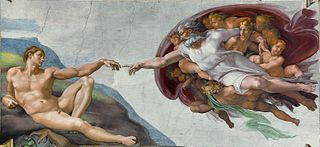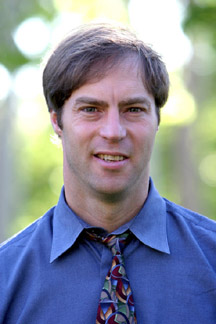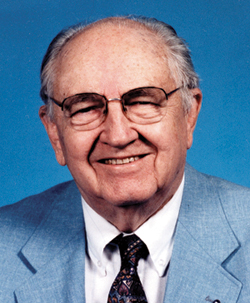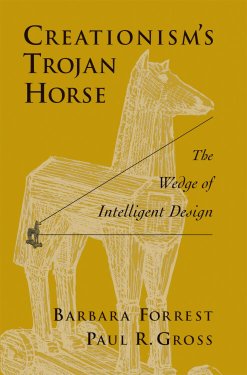
Creation science or scientific creationism is a pseudoscientific form of Young Earth creationism which claims to offer scientific arguments for certain literalist and inerrantist interpretations of the Bible. It is often presented without overt faith-based language, but instead relies on reinterpreting scientific results to argue that various myths in the Book of Genesis and other select biblical passages are scientifically valid. The most commonly advanced ideas of creation science include special creation based on the Genesis creation narrative and flood geology based on the Genesis flood narrative. Creationists also claim they can disprove or reexplain a variety of scientific facts, theories and paradigms of geology, cosmology, biological evolution, archaeology, history, and linguistics using creation science. Creation science was foundational to intelligent design.
Intelligent design (ID) is a pseudoscientific argument for the existence of God, presented by its proponents as "an evidence-based scientific theory about life's origins". Proponents claim that "certain features of the universe and of living things are best explained by an intelligent cause, not an undirected process such as natural selection." ID is a form of creationism that lacks empirical support and offers no testable or tenable hypotheses, and is therefore not science. The leading proponents of ID are associated with the Discovery Institute, a Christian, politically conservative think tank based in the United States.
Irreducible complexity (IC) is the argument that certain biological systems with multiple interacting parts would not function if one of the parts were removed, so supposedly could not have evolved by successive small modifications from earlier less complex systems through natural selection, which would need all intermediate precursor systems to have been fully functional. This negative argument is then complemented by the claim that the only alternative explanation is a "purposeful arrangement of parts" inferring design by an intelligent agent. Irreducible complexity has become central to the creationist concept of intelligent design (ID), but the concept of irreducible complexity has been rejected by the scientific community, which regards intelligent design as pseudoscience. Irreducible complexity and specified complexity, are the two main arguments used by intelligent-design proponents to support their version of the theological argument from design.
Edwards v. Aguillard, 482 U.S. 578 (1987), was a United States Supreme Court case concerning the constitutionality of teaching creationism. The Court considered a Louisiana law requiring that where evolutionary science was taught in public schools, creation science must also be taught. The constitutionality of the law was successfully challenged in District Court, Aguillard v. Treen, 634 F. Supp. 426, and the United States Court of Appeals for the Fifth Circuit affirmed, Aguillard v. Edwards, 765 F.2d 1251. The United States Supreme Court ruled that this law violated the Establishment Clause of the First Amendment because the law was specifically intended to advance a particular religion. In its decision, the court opined that "teaching a variety of scientific theories about the origins of humankind to school children might be validly done with the clear secular intent of enhancing the effectiveness of science instruction."

Michael Joseph Behe is an American biochemist and an advocate of the pseudoscientific principle of intelligent design (ID).

Arthur Ernest Wilder-Smith, FRSC was a British organic chemist and young Earth creationist.

The history of creationism relates to the history of thought based on the premise that the natural universe had a beginning, and came into being supernaturally. The term creationism in its broad sense covers a wide range of views and interpretations, and was not in common use before the late 19th century. Throughout recorded history, many people have viewed the universe as a created entity. Many ancient historical accounts from around the world refer to or imply a creation of the earth and universe. Although specific historical understandings of creationism have used varying degrees of empirical, spiritual and/or philosophical investigations, they are all based on the view that the universe was created. The Genesis creation narrative has provided a basic framework for Jewish and Christian epistemological understandings of how the universe came into being – through the divine intervention of the god, Yahweh. Historically, literal interpretations of this narrative were more dominant than allegorical ones.

Stephen C. Meyer is an American author and former educator. He is an advocate of the pseudoscience of intelligent design and helped found the Center for Science and Culture (CSC) of the Discovery Institute (DI), which is the main organization behind the intelligent design movement. Before joining the DI, Meyer was a professor at Whitworth College. Meyer is a senior fellow of the DI and director of the CSC.

Henry Madison Morris was an American young Earth creationist, Christian apologist and engineer. He was one of the founders of the Creation Research Society and the Institute for Creation Research. He is considered by many to be "the father of modern creation science". He coauthored The Genesis Flood with John C. Whitcomb in 1961.

Of Pandas and People: The Central Question of Biological Origins is a controversial 1989 school-level supplementary textbook written by Percival Davis and Dean H. Kenyon, edited by Charles Thaxton and published by the Texas-based Foundation for Thought and Ethics (FTE). The textbook endorses the pseudoscientific concept of intelligent design – the argument that life shows evidence of being designed by an intelligent agent which is not named specifically in the book, although proponents understand that it refers to the Christian God. The overview chapter was written by young Earth creationist Nancy Pearcey. They present various polemical arguments against the scientific theory of evolution. Before publication, early drafts used cognates of "creationist". After the Edwards v. Aguillard Supreme Court ruling that creationism is religion and not science, these were changed to refer to "intelligent design". The second edition published in 1993 included a contribution written by Michael Behe.
An intelligent designer, also referred to as an intelligent agent, is the pseudoscientific hypothetical willed and self-aware entity that the intelligent design movement argues had some role in the origin and/or development of life. The term "intelligent cause" is also used, implying their teleological supposition of direction and purpose in features of the universe and of living things.
Percival William Davis, also known as Bill Davis, is an American author, young earth creationist, and intelligent design proponent.
Dean H. Kenyon is Professor Emeritus of Biology at San Francisco State University, a young Earth creationist, and one of the instigators of the intelligent design movement. He is the author of Biochemical Predestination.

Neo-creationism is a pseudoscientific movement which aims to restate creationism in terms more likely to be well received by the public, by policy makers, by educators and by the scientific community. It aims to re-frame the debate over the origins of life in non-religious terms and without appeals to scripture. This comes in response to the 1987 ruling by the United States Supreme Court in Edwards v. Aguillard that creationism is an inherently religious concept and that advocating it as correct or accurate in public-school curricula violates the Establishment Clause of the First Amendment.
Paul A. Nelson is an American philosopher, noted for his advocacy of the pseudosciences of young earth creationism and intelligent design.

Creationism's Trojan Horse: The Wedge of Intelligent Design is a 2004 book by Barbara Forrest and Paul R. Gross on the origins of intelligent design, specifically the Discovery Institute's Center for the Renewal of Science and Culture and its wedge strategy. The authors are highly critical of what they refer to as intelligent design creationism, and document the intelligent design movement's fundamentalist Christian origins and funding.

Evolution: A Theory in Crisis is a 1985 book by Michael Denton, in which the author argues that the scientific theory of evolution by natural selection is a "theory in crisis". Reviews by scientists say that the book distorts and misrepresents evolutionary theory and contains numerous errors.

This timeline of intelligent design outlines the major events in the development of intelligent design as presented and promoted by the intelligent design movement.

The Edge of Evolution: The Search for the Limits of Darwinism is an intelligent design book by Discovery Institute fellow Michael Behe, published by the Free Press in 2007. Behe argues that while evolution can produce changes within species, there is a limit to the ability of evolution to generate diversity, and this limit is somewhere between species and orders. On this basis, he says that known evolutionary mechanisms cannot be responsible for all the observed diversification from the last universal ancestor and the intervention of an intelligent designer can adequately account for much of the diversity of life. It is Behe's second intelligent design book, his first being Darwin's Black Box.

Explore Evolution: The Arguments For and Against Neo-Darwinism is a controversial biology textbook written by a group of intelligent design supporters and published in 2007. Its promoters describe it as aimed at helping educators and students to discuss "the controversial aspects of evolutionary theory that are discussed openly in scientific books and journals but which are not widely reported in textbooks." As one of the Discovery Institute intelligent design campaigns to "teach the controversy" its evident purpose is to provide a "lawsuit-proof" way of attacking evolution and promoting pseudoscientific creationism without being explicit.









